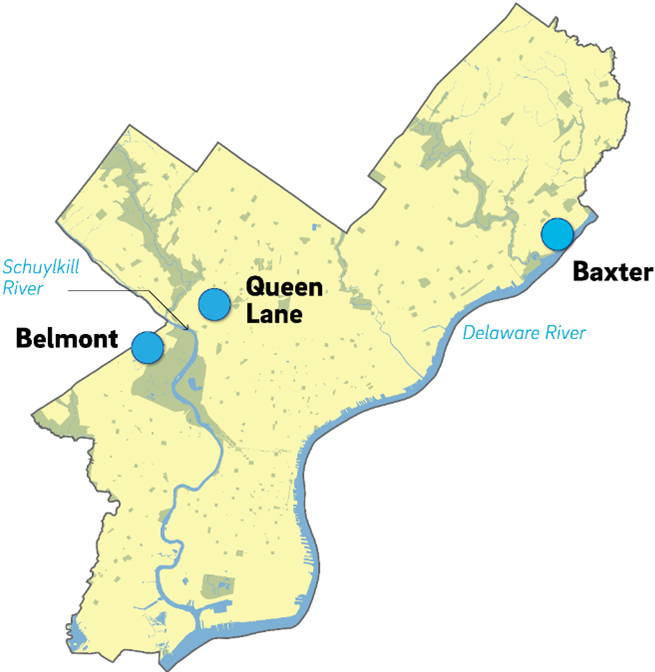PFAS are a group of long-lasting, human-made chemicals found everywhere in the environment. PWD is committed to ensuring PFAS levels in drinking water are below all state and federal regulations.

PFAS: What Are They?
- Human-made perfluoroalkyl and polyfluoroalkyl substances—called PFAS—have been used in industrial applications and a wide range of consumer products including cookware, fabrics, paper products and firefighting foams. There are more than 15,000 types of PFAS compounds.
- Substances in the PFAS family are not found in water alone. PFAS are widespread around the world in air and soil, and they are even found in remote environments such as the Arctic.
- These compounds have been used globally for decades and are sometimes called “forever chemicals” because they do not break down naturally.
- Exposure to certain levels of PFAS can have adverse effects on your health. Studies have linked some types of PFAS compounds, such as PFOS and PFOA, to negative reproductive effects, decreased immune system response, and increased risk for some types of cancer. Other types of PFAS are still being studied for their effects on human health.
Customer and Safety Concerns
- In our region, PFAS have been detected in both groundwater and surface water that supply drinking water for millions of people. Philadelphia’s drinking water comes from the Delaware and Schuylkill rivers.
- There are still many other commercial and industrial sources that need to be evaluated. PFAS can be found around the world in air, water, and food.
- The state of Pennsylvania has set drinking water standards for two PFAS compounds known as PFOS and PFOA. The Environmental Protection Agency (EPA) has also set a stricter national limit for some PFAS substances.
- PFAS can be removed from water through advanced treatment processes. PWD is planning and piloting new treatment methods at some of our plants.
- Bottled water is not a PFAS-free alternative to tap water. Some at-home water filters can reduce the level of PFAS in your drinking water, but they won’t remove PFAS entirely.
- You can reduce your exposure to PFAS through awareness of their presence in damaged nonstick cookware, household dust, personal care products, food packaging, and cleaning products.
Philadelphia Water Department Actions
PFAS contamination is the result of decades of environmental pollution and is a problem that cannot be solved by water utilities alone. PFAS producers and manufacturers must be held accountable for the control of this pollution at its sources and for its cleanup throughout the region. Although we are faced with a difficult environmental problem to solve, PWD is taking action to ensure the integrity of your drinking water.
PWD routinely monitors PFAS levels in drinking water.
Understanding the occurrence of PFAS in drinking water is a key component of our management strategy. View results from PWD’s 2021-2023 voluntary sampling for PFAS in Drinking Water
The table below displays testing results to comply with PFAS drinking water regulations, or maximum contaminant levels (MCLs), at PWD’s three treatment plants. This table includes the current applicable MCL from the Pennsylvania Department of Environmental Protection (PA DEP) and the MCL developed by the EPA that will go into effect in 2031.
Compliance samples are collected and analyzed quarterly, and a running annual average is calculated. Under both EPA and DEP regulations, any detections less than 4 ppt are counted as zero for the running annual averages.
Visit the EPA website to learn more about the EPA regulation and the hazard index (a calculation based on the mixture of 4 PFAS compounds).

| Parameter | PA DEP MCL (ppt) | EPA MCL (ppt) | Running Annual Average (ppt) | ||
|---|---|---|---|---|---|
| Baxter | Queen Lane | Belmont | |||
| PFOA | 14 | 4 | 0 | 6.8 | 5.6 |
| PFOS | 18 | 4 | 0 | 4.6 | 2.4 |
| PFBS | N/A | N/A | 0 | 5.2 | 4.5 |
| PFHxS | N/A | 10 | 0 | 0 | 0 |
| PFNA | N/A | 10 | 0 | 0 | 1 |
| HFPO-DA (Gen X) | N/A | 10 | 0 | 0 | 0 |
| Hazard Index | N/A | 1 | 0 | 0 | 0.1 |
PWD participated in monitoring required by the EPA under the Fifth Unregulated Contaminant Monitoring Rule, which included analysis of 29 PFAS compounds in drinking water. View the 2024 UCMR5 Results.
Additionally, PWD published the PFAS Drinking Water Characterization Study to summarize drinking water results from 2021-2022 and provide context for our customers.
PWD investigates PFAS levels in source water.
In 2020, PWD published a report detailing the levels of PFAS detected in the rivers and creeks that supply our drinking water. Read the PFAS Water Resources Characterization Study.
PWD is piloting new technologies to remove PFAS.
Advanced treatment technologies such as granular activated carbon, ion exchange, and reverse osmosis can remove PFAS from water. PWD is testing new treatment options with a pilot project and is evaluating the most efficient an cost-effective options.
PWD plans for PFAS impacts in the decades to come.
Upgrading a drinking water system that serves 1.6 million people is no small task. PWD is carefully considering the financial and operational changes that must happen to address PFAS. This includes smart investment in new infrastructure that will serve the future needs of the city of Philadelphia.
PWD collaborates with neighboring utilities and government agencies.
PWD supports the regulation of PFAS in drinking water and cooperates with multiple agencies and partners in research and planning. PFAS contamination is a global issue, and PWD is not alone in learning about ways to address this challenge.
PWD communicates openly and transparently about PFAS to our customers.
All PFAS testing data for drinking water is available through this web page. If you have further concerns or questions, please email waterinfo@phila.gov.
PFAS Resources
- PFAS Resources from the American Water Works Association
- PFAS In Pennsylvania from Pennsylvania Department of Environmental Protection
- PFAS Information from the US Environmental Protection Agency
- PWD Public Comments on Pennsylvania’s Maximum Contaminant Level Rule for Drinking Water
- PWD Public Comments on US EPA’s Maximum Contaminant Level Rule for PFAS
The information contained herein is dated as of January 2025 and is subject to change without notice. The Philadelphia Water Department undertakes no obligation to update the information contained herein as a result of any future changes or regulations.
